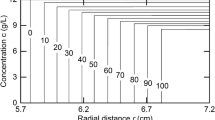Abstract
ZONE centrifugation through sucrose density gradients is widely used for the separation of substances differing in their sedimentation behaviour, and has been applied to viruses, ribosomes and proteins. The principal advantage of this technique is that components of a mixture which have been separated by centrifugation may be recovered readily and examined for such properties as content of radioactive tracers, chemical composition and biological activity. However, it is frequently necessary to measure also an optical parameter, such as the absorption of ultraviolet light, as a function of depth in the centrifuge tube. The method commonly used for this purpose involves puncturing the bottom of the centrifuge tube and fractionating the contents by collecting drops as they emerge. The fractions are then examined individually. Such a method is time-consuming and lacking in sensitivity and resolution. In this laboratory a simple method has been developed for automatically obtaining a continuous record of optical density versus sedimentation distance, which makes use of the stable and adaptable optics, and the pen-chart system of a commercial recording spectrophotometer, in this case the Cary model 14.
Similar content being viewed by others
Author information
Authors and Affiliations
Rights and permissions
About this article
Cite this article
EDWARDS, J., MATHIAS, A. Apparatus for the Automatic Location of Absorbing Components separated by Density Gradient Centrifugation. Nature 199, 603–604 (1963). https://doi.org/10.1038/199603a0
Issue Date:
DOI: https://doi.org/10.1038/199603a0
- Springer Nature Limited
This article is cited by
-
Characterization of a nonsense mutation affecting the activity of the dissociation factor of Escherichia coli ribosomes
Molecular and General Genetics MGG (1971)





